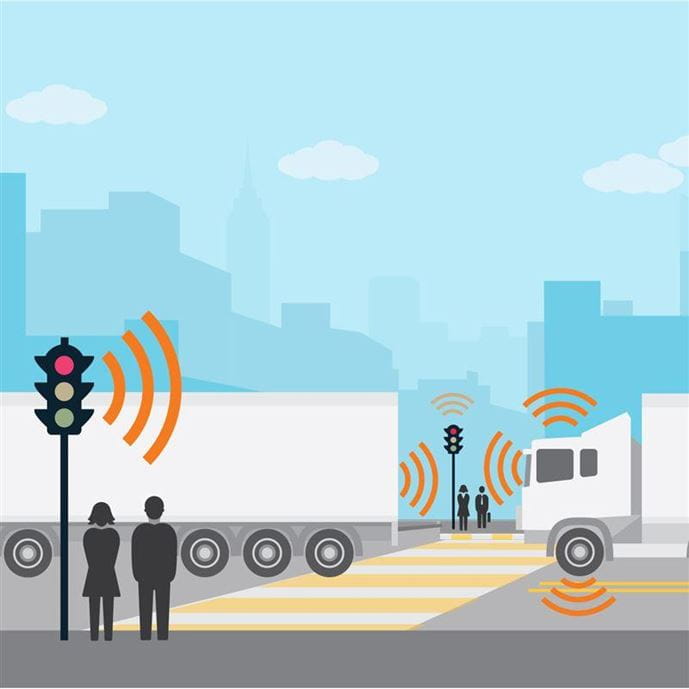Driving Innovation with Urban Truck Parking Technology
Freight-specific technology applications like Freight Advanced Traveler Information Systems (FRATIS) originated as a way to solve a daily problem: cross-town container movement. The concept used breakthroughs in dynamic travel planning and performance data sharing to improve operational efficiency and promote effective decision making. Today, FRATIS has matured and is now a viable option for trucking operations optimization by combining real-time traffic data with truck parking information to keep drivers safe and move freight forward.
Solving for an Age-Old Transportation Problem
Truck parking consistently ranks among the top problems reported in the American Trucking Associations Research Institute (ATRI) annual surveys. The combination of increased commercial motor vehicle traffic, recent changes to hours of service (HOS) rules, tighter delivery schedules and federally regulated limits on driving time has led to an increased demand for safe commercial truck parking. This problem is most apparent in urban areas, including in Southern Nevada and Southern California where truck parking is made even more challenging due to clustered businesses and high volumes of freight and vehicle movement.
Over the past several years, initiatives have been underway to find innovative ways to increase legal truck parking in urban areas. Even so, communications technology is the undisputed key to guiding drivers to available parking. So what’s the solution? It includes tapping into emerging tech to utilize the integration of commercial parking information with freight traveler data to allow truck drivers to adjust their routing and parking plans, while meeting hours of service (HOS) rules and making on-time deliveries.
CDM Smith has been leading the development of decision support systems to facilitate travel information by integrating existing transportation data on travel times and incidents with real-time data (like weather, congestion and reservation requests) and truck parking information. The Freight Advanced Traveler Information System + Truck Parking (FRATIS-P), based on the research work done by the Federal Highway Administration, is a concept that will meet the decision support system needs for many forward-thinking clients.
Not only will FRATIS-P improve motor carrier efficiency and highway safety, but it will also expand the quantity and quality of data that can be shared among public and private systems.
Integrating Truck Parking Management: How FRATIS-P Works
The process starts with performing traffic studies of the various urban areas to identify current and potential truck parking sites as well as their relationships to freight pick-up and delivery locations. Our team reviews previous traffic studies conducted by the state, regional, or local governments and then analyzes traffic operations to determine the number, movements, and classifications of roadway vehicles operating in an urban area. This data will help identify critical flow time periods and determine the trends and influence of trucks on vehicular traffic flow.
FRATIS-P relies on the integration of several different technology systems:
-
Truck Parking Information Services: A network of commercial and public facilities that provide information on the availability and reservation of truck parking in the driver’s surrounding area.
-
Alternate Routing Services: A truck-specific GPS navigation solution that accounts for truck-restricted and prohibited roads, as well as nearby congestion and accidents. Based on truck dimensions provided by the driver (i.e., height, length, width, and weight per axle weight), the system will calculate the optimal route that is both safe and legal to avoid delays and damage to the vehicle.
-
Predictive Truck Travel Services: Considers the driver’s current location, predicted arrival time, current traffic conditions, historical traffic averages and estimated hours of service remaining in his/her log. The model also considers other factors like persistent trends (seasons, holidays and months), temporal patterns (construction) and changing trends (weather).
-
Predictive Traffic and Road Weather Data Analytics: Combines a series of traffic data from various monitoring sources and remote sensors with information from the traffic data warehouse. From this data set, high-quality forecasts are derived using data fusion algorithms to provide medium to longer-term alerts and warnings to users.
So let’s say a driver is completing her route in an urban area like Atlanta. She’s set to reach her destination at 10:00 PM, but the location only takes shipments during regular business hours. Instead of waiting until she reaches her destination to look for nearby parking, the driver can launch the FRATIS-P app, which pulls data from historical records and sensors to predict available truck parking locations near her delivery point. While driving, she’ll receive real-time updates on driving conditions and traffic patterns to help her make informed decisions along the way. And once she’s completed her stop, the driver can use FRATIS-P will find truck-approved routes that avoid congestion, construction, and incident delays on her return home.
The Impacts on Your Organization
Not only will an enterprise-level application of FRATIS-P dramatically improve motor carrier efficiency and highway safety, but it will also expand the quantity and quality of data that can be shared among public and private systems. Operational impacts will manifest in less time spent in traffic, fewer instances of drivers needing to park in unsanctioned areas and improvements in compliance with hours of service regulations.

The combination of increased commercial vehicle traffic, changes to HOS rules, tighter delivery schedules and federal limits on driving time has led to an increased demand for safe commercial truck parking.








